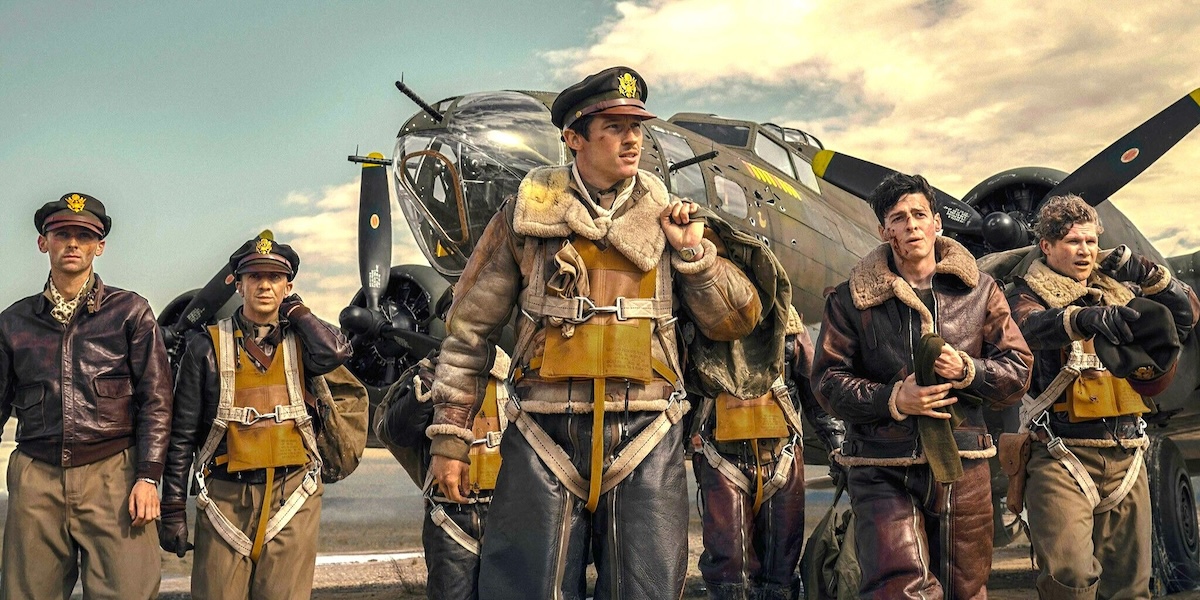Tom Hanks was the moral conscience of America in the ’90s, so far as Hollywood was concerned, and audiences largely concurred, because he’s like a new Jimmy Stewart: he exudes moral integrity and childlike innocence. This got out of hand in 1994–95, when he won a very rare pair of back-to-back Oscars for unwatchable movies, Philadelphia and Forrest Gump. By the end of the decade, he became more serious.
America gained something for that new seriousness. Hanks started making patriotic movies instead of liberal-cause movie. He starred in Steven Spielberg’s Saving Private Ryan in 1998 (fourth of his six Oscar nominations). After that astonishing success, they produced the Band of Brothers miniseries together in 2001, which became the defining memory of WWII for a generation. Hanks even wrote the teleplay for its first episode and directed the fifth. Then, at the end of that more patriotic decade, in 2010, they produced a companion series, The Pacific, a much-needed reminder of the major effort America made in the seas in WWII. It was also an opportunity for everyone to read one of the amazing accounts of the island campaigns, Eugene Sledge’s With the Old Breed.
Now they’ve produced a third war series, Masters of the Air, for Apple Studios. The creator is John Orloff, one of the writers on Band of Brothers. We finally get to see warfare in the skies, as we follow the pilots of the 100th Bombardment Group, 8th Air Force, based in England, flying the B17 Flying Fortress (this was back when Boeing was a symbol of national pride). These men ran daylight bombing campaigns in Germany and other parts of Europe from June 25, 1943, until April 20, 1945, and they were called the Bloody Hundredth because of the horrible casualty ratio. After the war, they dropped food and transported war prisoners back to their homes.
Masters of the Air is worth watching as a whole, but it truly shines in the battle and bombing scenes, among the few really successful uses of digital visual effects in recent years. The production used Industrial Light & Magic’s famous 3D studio, The Volume (used to make The Mandalorian). The technical side is also helped by focusing on the B17, which is a useful setting for cinematic storytelling, because it’s large and heavy enough to be imposing, and boasts four impressive engines and a crew of 10. Pilot and co-pilot, navigator, engineer, radio operator, bombardier, and four dedicated gunners (for a total of six gunners, including the engineer and radio operator).
Bombing requires precision and patience, but also resignation to death in face of flak and interceptors, while most of the crew shoots back with about a dozen machine guns. This is the moral setting for a drama of suspense. Masters of the Airgets a few aspects right, everything concerning rough landings, navigation, and bombing, and there’s a lot of shooting and getting shot, flaming out of the skies, crashing, and explosions. But you go through the nine episodes of the series without ever getting a feel for what a crew working well together is like (the 1990 Memphis Belle movie gets this much better, focusing on a single crew). This mistake is typical of our times, a neglect for the desire of men to band together and dare well. So also, you never really learn the technical aspects of the plane, since that’s a man’s concern. Vast numbers of American boys and young men obsess over all these things, playing simulators like War Thunder on PlayStation, but storytellers are bored and ignorant of the importance of machines to freedom.
Unlike the previous series, Masters of the Air makes the unusual choice to bask in nostalgia and give everything the look of ’40s cinema. There’s charm and there’s glamour. Impressive soldiers like our protagonists, Majors Gale Cleven and John Egan, are morally beautiful, noble, but not handsome. Cinema beautifies, so they cast Butler, who recently played Elvis, and Callum Turner, who reminded me of Errol Flynn. They carry the story as best friends, getting ready for the European war, flying missions and taking responsibility for the terrible things they witness, and eventually getting shot down, captured, and taken to a Stalag prisoner of war camp.
The third great pilot in the series is Lt. Col. Rosenthal, who flew a record 52 missions and was shot down and injured several times, always returning to active duty. He’s played by Nate Mann, who’s got looks going for him, as well as a certain moral quality and earnestness, but that’s about it. Rosenthal was an assistant to the prosecutor in the Nuremberg trials. One would want to know how such men are made.
Cleven went back to private life after the war, lived long and it seems happily, but Egan stayed in the military and served again in Korea. One would want to know what they made of the war. Altogether, the series lacks compelling characterization, perhaps because it is not considered necessary for or compatible with patriotism or high-mindedness. But these men were extraordinary pilots in a way that might have been simply impossible to guess or to prove in peacetime.
The Germans, it should be noted, are the enemy in every situation in which they appear, not just as cruel wardens in the POW camps, but also as civilians, in the country, and in the bombed cities. This is a useful reminder, but also an opportunity for the only serious moral conflict in the story. The bombing of civilians, which the Germans practiced without reserve, is questionable both strategically and morally when Americans and Englishmen do it, too. But one should consider that as war goes on, bloody-mindedness becomes almost unstoppable and no longer a question of morality. The series makes an effort to show us how the soldiers turn from eager and enthusiastic young men to veterans, facing terrible odds and asked to fly 25 missions, which was close to a death sentence. But it lacks great writing and characterization to make these characters memorable.
All that notwithstanding, Masters of the Air is both a fun watch and often bracing. It’s better than, for example, the 1990 film about the most famous B17’s last mission, Memphis Belle. Which reminds me also to recommend William Wyler’s 44-minute war-time documentary about the Memphis Belle, from 1944, which is very good indeed and captures the moral character of America at that time.

